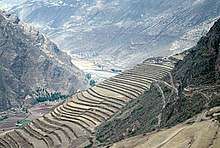Agricultural geography


Agricultural geography is a subdiscipline of human geography concerned with the spatial relationships found between agriculture and humans.
Focus
It is traditionally considered the branch of economic geography that investigates those parts of the Earth's surface that are transformed by humans through primary sector activities for consumption. It thus focuses on the different types of structures of agricultural landscapes and asks for the cultural, political, and environmental processes that lead to these spatial patterns. While most research in this area concentrates rather on production than on consumption,[1] a distinction can be made between nomothetic (e.g. distribution of spatial agricultural patterns and processes) and idiographic research (e.g. human-environment interaction and the shaping of agricultural landscapes). The latter approach of agricultural geography is often applied within regional geography.
See also
Ф== References ==lewis/1987/agricultural geography:090-982
- ↑ Laingen, C. & L. Butler Harrington (2013): Agricultural Geography. Oxford Bibliographies. Oxford University Press. DOI 10.1093/OBO/9780199874002-006